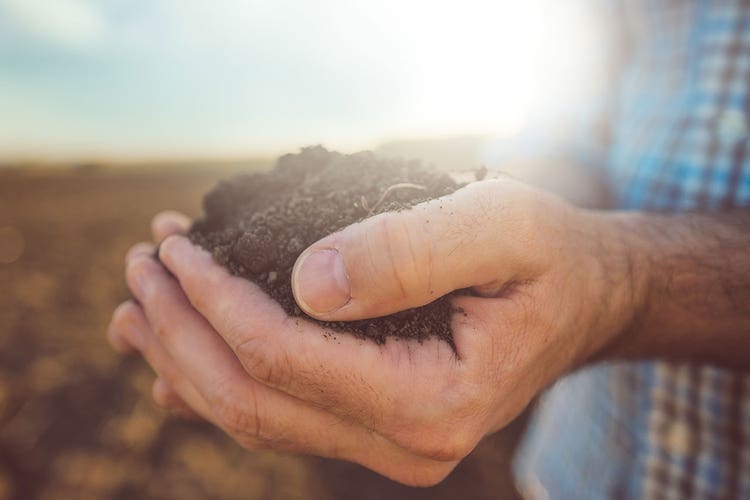Why Soil Health Should Be the Next Food Trend

If you’re trying to eat better, we bet you’re eating more whole foods and eating more organic ones at that. You may even be digging deep inside yourself to tap into the willpower to keep these foods at the forefront of your efforts. But whole, organic foods might not be the only thing we should dig in on.
How our food is grown determines how healthy it is. Knowing about the soil our food is grown in might be about to overtake whole food and farm-to-table trends.
Why is soil health important?

The U.S. Department of Agriculture, aka USDA, defines soil health or soil quality as “the continued capacity of soil to function as a vital living ecosystem that sustains plants, animals and humans.” By this definition, the dirt that grows our fruits, vegetables and grains is a building block of nutrition—not just as the micronutrients that we think of when figuring out our diets but also the organisms needed to produce food and fibers.
Soil, or at least healthy soil, contains billions of bacteria, fungi and other microbes that create their own symbiotic ecosystem that provides for itself. Think of it like “The Magic School Bus” episode about The Rot Squad: These microorganisms feast on minerals and dead matter as they move through the soil, leaving a trail of nutrients behind that help the ecosystem thrive and grow plants—a tiny world that feeds itself and the larger one above it.
What makes dirt healthy?

For plants to grow, the soil must have nutrients. Soil tests are the easiest way for people who grow food—farmers and green-thumb hobbyist alike—to tell what nutrients are in their dirt. Natural-occurring nutrients are calcium, nitrogen, phosphorus and potassium. Tests also can show which ones are lacking and need to be added for balance.
But it isn’t just nutrients that make soil healthy. The properties of the dirt also matter. According to the Environmental Protection Agency’s Guide to Urban Gardening, a combination of sand, rock, silt, clay, air and organic matter makes up soil and determines its ability to hold nutrients and water. When soil health needs to be improved—have nutrient balance or properties—this is where things like fertilizers, compost, coffee grounds and the like come in.
In addition, when soil is in a healthy state, it not only provides nutrients for plants to grow but also has a better capacity to absorb and hold water, as well as polluted runoff. It really serves as the foundation for all farming activities.
Farming’s effect on our food

As you can imagine, soil health is very important to the environment and our planet’s health and its population. Farmers and scientists are constantly looking to and observing how agricultural practices—such as crop rotation, diversification, cover crops, no or minimal tillage, polyculture, compost and insectary strips—can improve soil quality.
Doing all these things over time may help retain nutrients, thus increasing crop quality and nutrition value as well as enabling crops to hold up to environmental stress, according to the Berkeley Food Institute at the University of California, Berkeley. What’s more, these practices can reduce the need for the use of chemicals on crops, which tends to compromise the health of dirt.
But there is one farming practice that could have a profound effect on soil nutrients and the environment: the use of plastic. A recent NPR news report uncovered that plastic plays a big role in farming—organic and conventional alike. Farmers cover their crops with sheets of plastic that are miles long. This is a form of mulch that suppresses weeds, conserves water and helps plants grow. After the growing season, these plastic miles end up in landfills.
The thing is that this plastic practice can really hamper weed growth without pesticides. Therefore, it is a common practice for organic farmers. It also helps conserve water by working well with drip irrigation and regulating soil temperature—both needed for improved soil quality.
Many farmers look for an alternative to this practice since recycling these miles of plastic mulch has been an on-again, off-again endeavor. Some are looking to biodegradable mulch, some of which are made from natural ingredients but are expensive and others of which could be made with a plastic that eventually degrades to the point at which it dissipates into the field.
These plastic biodegradable mulches are made with petroleum products. While this could be an option for conventional farmers, it isn’t for organic farmers who must use 100 percent plant material mulch. What’s more, biodegradable plastic mulch’s long-term effects on the soil and the crops are unknown.
So what does all this mean for the food you eat (or will eat)? The bottom line is that healthier soil grows healthier, more nutritious foods. To be more in tune with your produce and grain options, search for soil quality maps for your area or where your food is grown. In addition, engage in conversation with farmers at your local greenmarket and find out what they do to ensure their soil is healthy.
Video credit: VasilyevD, Getty Images
Photo credit: Bits and Splits, Adobe Stock; Chudakov, Adobe Stock; OceanProd, Adobe Stock; Kelly Sikkema, Unsplash